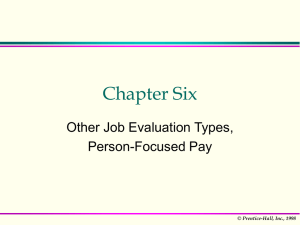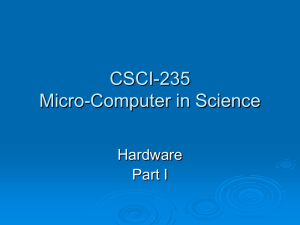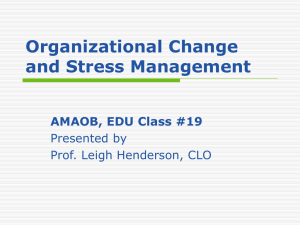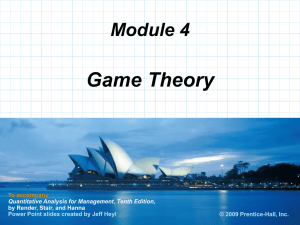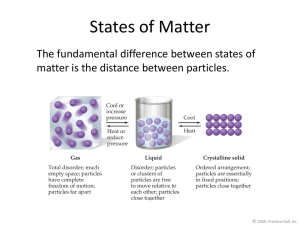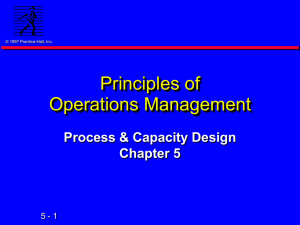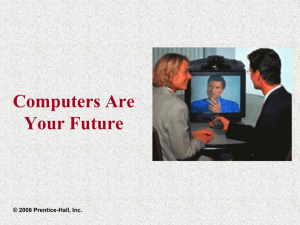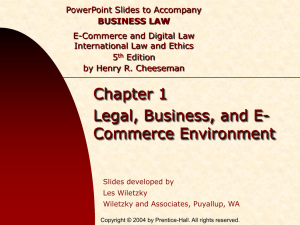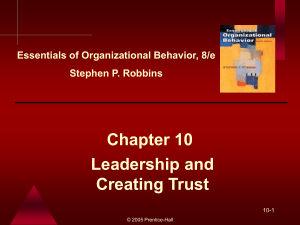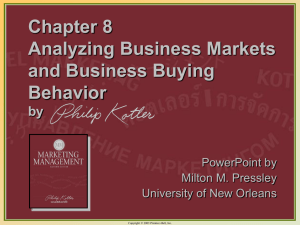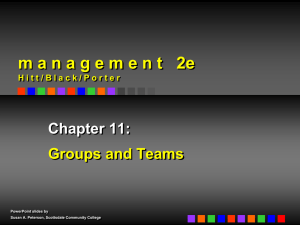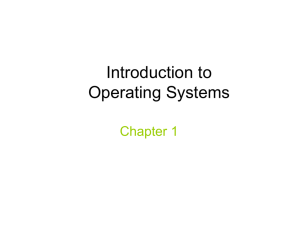Chap. 3: Total Quality Management
advertisement
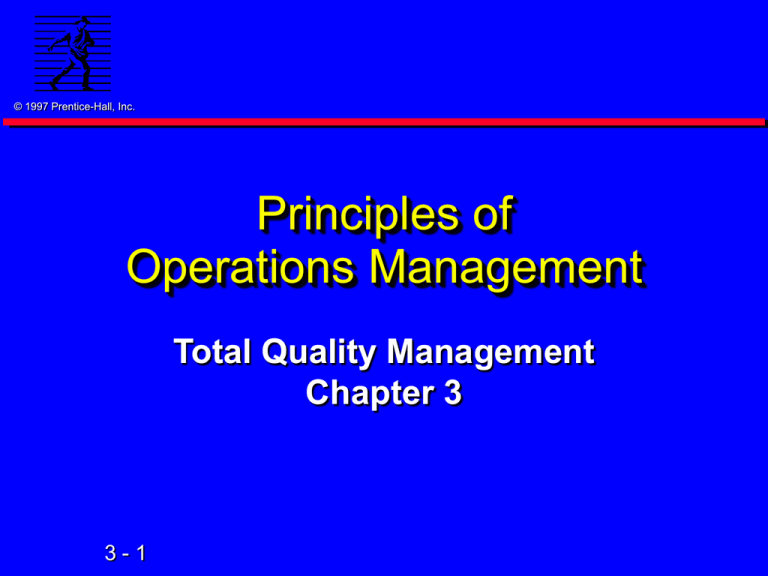
© 1997 Prentice-Hall, Inc. Principles of Operations Management Total Quality Management Chapter 3 3-1 Learning Objectives © 1997 Prentice-Hall, Inc. Define quality State why quality is important Explain total quality management (TQM) Explain tools for total quality management Describe inspection 3-2 Definitions of Quality © 1997 Prentice-Hall, Inc. ASQC: Product characteristics & features that affect customer satisfaction User-Based: What consumer says it is Mfg.-Based: Degree to which a product conforms to design specification Product-Based: Level of measurable product characteristic 3-3 © 1997 Prentice-Hall, Inc. Dimensions of Quality for Goods Operation Reliability & durability Conformance Serviceability Appearance Perceived quality 3-4 Quality Importance of Quality © 1997 Prentice-Hall, Inc. Costs & market share Company’s reputation Product liability Improved Improved Quality Quality International implications 3-5 Market Market Gains Gains Reputation Reputation Volume Volume Price Price Increased Increased Profits Profits Lower Lower Costs Costs Productivity Productivity Rework/Scrap Rework/Scrap Warranty Warranty © 1997 Prentice-Hall, Inc. Industrial Standard Z8101-1981 (Japan) Common quality standards for products sold in Europe (even if made in U.S.) ISO 14000 series (Europe/EC) Specification for TQM ISO 9000 series (Europe/EC) International Quality Standards Standards for recycling, labeling etc. ASQC Q90 series; MILSTD (U.S.) 3-6 © 1997 Prentice-Hall, Inc. Malcolm Baldrige National Quality Award Established in 1988 by the U.S. gov’t Designed to promote TQM practices Some criteria Senior executive leadership; strategic planning; mgt. of process quality Quality results; customer satisfaction Recent winners Corning Inc.; GTE; AT&T; Eastman Chem. 3-7 © 1997 Prentice-Hall, Inc. Traditional Quality Process (Mfg.) Customer Marketing Engineering Operations Specifies Need Interprets Need Designs Product Produces Product Defines Quality Plans Quality Quality is customer driven! 3-8 Monitors Quality Total Quality Management © 1997 Prentice-Hall, Inc. Quality system involving entire organization from supplier to customer Objective: Meet or exceed customer needs through company-wide continuous improvement Early proponents W. Edwards Deming J. M. Juran Philip B. Crosby 3-9 © 1997 Prentice-Hall, Inc. Total Quality Management Principles Continuous improvement Employee empowerment Benchmarking Just-in-time (JIT) Knowledge of TQM tools © 1995 Corel Corp. 3 - 10 Continuous Improvement © 1997 Prentice-Hall, Inc. Represents continual improvement of process & customer satisfaction Involves all operations & work units Other names Kaizen (Japanese) Zero-defects Six sigma 3 - 11 © 1984-1994 T/Maker Co. Employee Empowerment © 1997 Prentice-Hall, Inc. Getting employees involved in product & process improvements 85% of quality problems are due to process & material © 1995 Corel Corp. Techniques Talk to workers Support workers Let workers make decisions Build teams & quality circles 3 - 12 Quality Circles © 1997 Prentice-Hall, Inc. Group of 6-12 employees from same work area Meet regularly to solve work-related problems 4 hours/month Facilitator trains & helps with meetings 3 - 13 © 1995 Corel Corp. Benchmarking © 1997 Prentice-Hall, Inc. Selecting best practices to use as a standard for performance Steps Determine what to benchmark Form benchmarking team Identify benchmarking partners Collect benchmarking information Take action to meet or exceed benchmark 3 - 14 © 1997 Prentice-Hall, Inc. Benchmarking Thinking Challenge What specific & measurable variables would you benchmark in these areas? Accounting Hotel front desk Data processing Marketing 3 - 15 Alone Group Class Just-In-Time (JIT) © 1997 Prentice-Hall, Inc. ‘Pull’ system of production/purchasing Customer starts production with an order Involves ‘vendor partnership programs’ to improve quality of purchased items Reduces all inventory levels Inventory hides process & material problems Improves process & product quality 3 - 16 TQM Tools © 1997 Prentice-Hall, Inc. Quality function deployment (QFD) Pareto charts Process charts Cause & effect diagrams Statistical process control (SPC) 3 - 17 © 1997 Prentice-Hall, Inc. Quality Function Deployment (QFD) Product design process using cross-functional teams Marketing, engineering, manufacturing Translates customer preferences into specific product characteristics Involves creating 4 tabular ‘Matrices’ or ‘Houses’ Breakdown product design into increasing levels of detail 3 - 18 © 1997 Prentice-Hall, Inc. House of Quality 1 Quality Function Deployment Sequence Product Char. Customer Req. House of Quality 3 Component Spec. 3 - 19 House of Quality 2 Component Spec. Product Char. Production Process House of Quality 4 Production Process Quality Plan House of Quality Example © 1997 Prentice-Hall, Inc. You’ve been assigned temporarily to a QFD team. The goal of the team is to develop a new camera design. Build a House of Quality. © 1984-1994 T/Maker Co. 3 - 20 House of Quality Example © 1997 Prentice-Hall, Inc. Cust. Req. Cust. Importance Target Values High relationship Medium relationship 3 - 21 Pareto Chart © 1997 Prentice-Hall, Inc. Vertical bar chart showing relative importance of problems or defects Makes identifying & solving them easier Based on Pareto Principle Most effects have relatively few causes e.g., 80% of quality problems come from 20% of machines, materials, or operators Focus on ‘vital few’ 20% causes Called 80-20 rule 3 - 22 © 1997 Prentice-Hall, Inc. Pareto Chart Thinking Challenge You’re a quality analyst for Corning Glass. You’ve collected data on 100 rejected glasses: Nicks 80 Cuts 11 Scratches 3 Porosity 3 Misc. 3 Prepare a Pareto Chart. 3 - 23 Alone Group Class Process Chart © 1997 Prentice-Hall, Inc. Shows sequence of events in process Depicts activity relationships Has many uses Identify data collection points Find problem sources Identify places for improvement Identify where travel distances can be reduced 3 - 25 Process Chart Example © 1997 Prentice-Hall, Inc. SUBJECT: Request tool purchase Dist (ft) Time (min) Symbol Description D Write order On desk D To buyer 75 D Examine = Operation; = Transport; = Inspect; D = Delay; = Storage 3 - 26 Cause & Effect Diagram © 1997 Prentice-Hall, Inc. Used to find problem sources/solutions Other names Fish-bone diagram, Ishikawa diagram Steps Identify problem to correct Draw main causes for problem as ‘bones’ Ask ‘What could have caused problems in these areas?’ Repeat for each sub-area. 3 - 27 © 1997 Prentice-Hall, Inc. Statistical Process Control (SPC) Uses statistics & control charts to tell when to adjust process Developed by Shewhart in 1920’s Involves Creating standards (upper & lower limits) Measuring sample output (e.g. mean wgt.) Taking corrective action (if necessary) Done while product is being produced 3 - 29 © 1997 Prentice-Hall, Inc. Statistical Process Control Steps Start Produce Good Provide Service Take Sample No Assign. Causes? Yes Inspect Sample Create Control Chart 3 - 30 Stop Process Find Out Why Control Chart Example © 1997 Prentice-Hall, Inc. UCL 3 - 31 11 Time 9 7 5 LCL 3 1 80 60 40 20 0 X © 1997 Prentice-Hall, Inc. Thinking Challenge: Compare & Contrast TQM Tools Bases 3 - 32 Alone Group Class Inspection © 1997 Prentice-Hall, Inc. Involves examining items to see if an item is good or defective Objective: Detect a defective product Does not correct deficiencies in process or product Issues When to inspect Where in process to inspect 3 - 33 © 1997 Prentice-Hall, Inc. When & Where to Inspect in Mfg. At supplier’s plant while producing Upon receipt of goods from supplier Before costly or irreversible processes During production process When production is complete Before shipment 3 - 34 © 1995 Corel Corp. © 1997 Prentice-Hall, Inc. Business When & Where to Inspect in Services Where Variable Bank Teller station Checking Store Stockrooms Stock rotation Display areas Attractiveness Counters Courtesy, knowledge 3 - 35 Speed, courtesy Accuracy TQM in Services © 1997 Prentice-Hall, Inc. Service quality is more difficult to measure than for goods Service quality perceptions depend on Expectations vs. reality Process & outcome Types of service quality Normal: Routine service delivery Exceptional: How problems are handled 3 - 36 Service Quality Attributes © 1997 Prentice-Hall, Inc. Reliability Responsiveness Tangibles Competence Understanding Access Security Courtesy © 1995 Corel Corp. Credibility 3 - 37 Communication Conclusion © 1997 Prentice-Hall, Inc. Defined quality Stated why quality is important Explained total quality management Explained tools for total quality management (TQM) Described inspection 3 - 38
